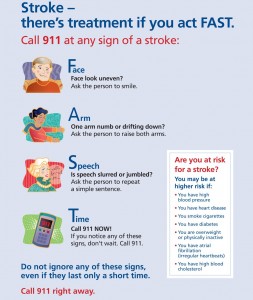Stroke, sometimes called a “brain attack,” occurs because there is sudden disruption of blood flow to part of the brain and brain cells are deprived of oxygen. Strokes can be caused by a clot obstructing blood flow (called an ischemic stroke), or by a ruptured blood vessel (called a hemorrhagic stroke). In either case, without oxygen brain cells begin to die within minutes. Timely treatment can mean the difference between a good outcome and significant disability.
“Research tells us that only about half of adults can name one or two symptoms of stroke,” Tracey Ash, Stroke program manager at Providence St. Peter Hospital says. “Recognition is the first step in treatment of a stroke.”
 In a proclamation designating May as Stroke Awareness Month, Gov. Jay Inslee urges all residents to learn the signs and symptoms of stroke, specifically FAST, a tool to recognize some of the most common symptoms:
In a proclamation designating May as Stroke Awareness Month, Gov. Jay Inslee urges all residents to learn the signs and symptoms of stroke, specifically FAST, a tool to recognize some of the most common symptoms:
- Face: Ask the person to smile – does one side of the face droop?
- Arms: Ask the person to raise both arms – does one arm drift downward or not move?
- Speech: Ask the person to repeat a simple sentence – do they sound slurred or strange?
- Time: Time to call 911 if you see any one of these signs
Other signs of stroke may include:
- Sudden severe headache with no known cause
- Sudden trouble walking
- Dizziness
- Loss of coordination
- Sudden trouble seeing in one or both eyes
- Sudden confusion
- Trouble understanding
If any of the above symptoms are present, it is time to call 911. Emergency Medical Services (EMS) providers are equipped with knowledge and resources that can get the person the treatment needed in the shortest amount of time. In Thurston County, EMS has specific protocols for evaluation and transport of patients with suspected stroke.
Sponsored


















































